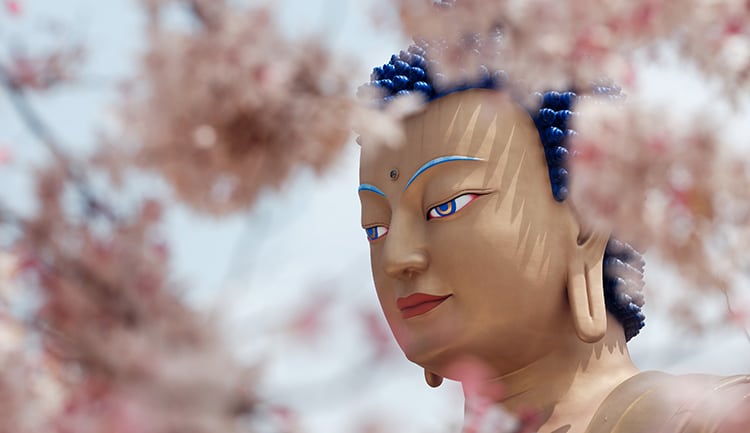Buddhism’s Three Types of Suffering
Category: Buddhist Path

Multiple times throughout the course of his life, the Buddha taught the four noble truths. The first of these is that life is suffering. Fortunately, this is followed by the truth that suffering has a cause, can be ended, and that there is a path that leads to the end of suffering.
But what is suffering, exactly? Many hear that ‘all life is suffering’ and disagree, for our lives are certainly punctuated by moments of happiness. For a closer look at the meaning of suffering, the Buddha taught that suffering is of 3 types. By understanding the 3 forms of suffering, we begin to understand the foundation of Buddhist spirituality.
Buddhism And The Concept Of Suffering
Suffering is perhaps the most common translation of dukkha, the Sanskrit word we find in Buddhist sutras. But the word dukkha is full of nuance. Suffering may refer to the acute physical pain of breaking our toe, and also to the emotional pain that occurs when we dwell in self pity in response. Suffering is even part of the joy we feel when we finally find relief. Because deep down, we know our medication will wear off or that we’ll get to the bottom of that chocolate bar that’s been providing us with distraction.
Dukkha refers to the inherent unsatisfactoriness of life. It’s our pain and our suffering, but also our discontentment, annoyance, our restlessness and unease. It’s the unsatisfactoriness the Buddha experienced in his life that led to his awakening, and it can be the same thing for us.
The Buddhist teachings on the three types of suffering are meant to help us become more aware of the subtleties of suffering and the myriad ways it arises in our experience. Becoming mindful of suffering and each of its manifestations is the first step in putting an end to it.
The Suffering Of Suffering
Of the three kinds of suffering, the first and perhaps easiest to understand is the suffering of suffering (dukkha-dukkha). This includes the suffering of physical pain. Even if we somehow manage to go through life without ever needing a band-aid, we cannot escape the pain of getting older, getting sick, and someday dying.
The suffering of suffering also describes emotional pain. Our feelings get hurt, we worry about the future, and we ruminate on our misfortunes. We suffer straight suffering anytime we find ourselves in a situation we’d rather be done with.
The Suffering Of Change
The suffering of change (viparinama-dukkha) arises from our inability to accept the truth of impermanence, or rather, from our tendency to forget it. If the suffering of suffering describes an experience we wish were over, the suffering of change can be seen as its opposite. We suffer even when experiencing pleasure, because deep down, we know it will eventually come to an end. Yes, there is suffering even in pleasure, indeed more subtle than what we overtly understand as pain.
The suffering of change refers not only to the impermanence of our physical bodies or sexual pleasure, but to the relief we assign to the raise we earned, the purchase of any material object, the meal we’re enjoying, and the relationships we cherish. All of it will someday change.
The Suffering Of Existence
The suffering of existence (sankhara-dukkha) is also known as all-pervasive suffering. This is the suffering which arises due to our failure to see the world as it really is. In Buddhist terms, this mistaken world view is referred to as ignorance. We think we know how things work, but we are mistaken. This confusion perpetuates itself in cyclic existence, the painful state of samsara.
We suffer in part because we don’t realize the true cause of our suffering. We continue to make the same mistake over and over again, attempting to avoid that which causes pain while seeking out that which causes pleasure. But if our ok-ness is dependent on the world around us being just-so, we’re doomed. For all things ultimately change. Even if we get exactly what we want, we cannot take it with us when we die.
Deep down, we understand this. It’s why discontentment, unease or a sense of groundlessness consistently perfumes every moment of our lives. The suffering of existence reminds us that the unenlightened life will always be unsatisfactory.
The Cessation of Suffering
So what are we to do? In our unawakened, ignorant state, suffering is unavoidable. But this truth offers us a clue to the solution. By developing an understanding of how the world really works, by seeing this directly through the experience of Buddhist meditation, and by then putting into practice the true causes of happiness, we have a way out. As the great meditation master Trungpa Rinpoche said, “the way out is the way in”.
Thankfully, the Buddha left us with a path that leads to the end of suffering. To begin, we turn from the habit of seeking solutions outside of ourselves, and turn instead to the process that occurs within.








